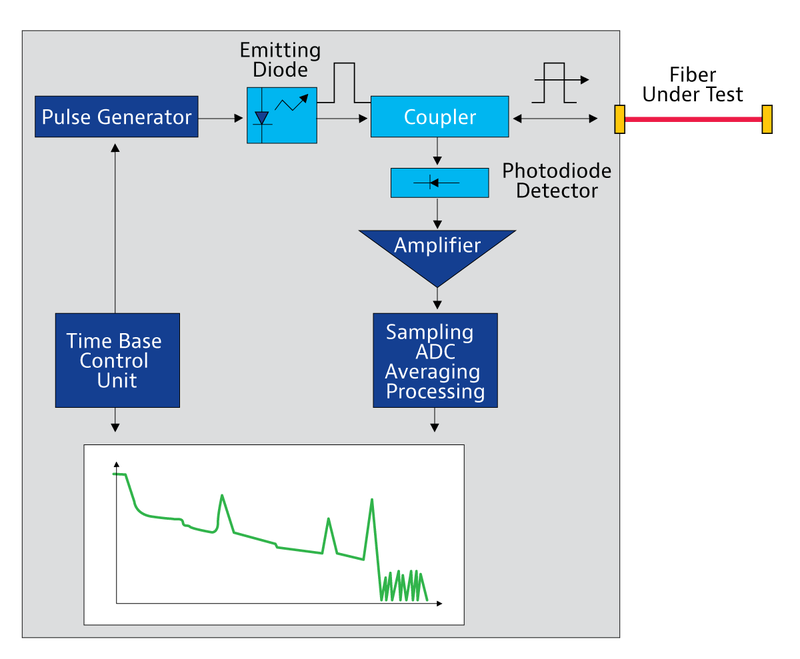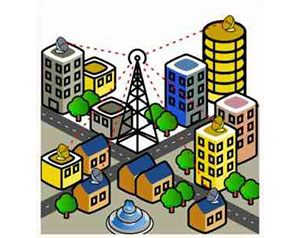
Optical Fibre Testing - OTDR
OTDR stands for Optical Time Domain Reflectometer that is a optical equipment widely used all across the world to check fibre optic loses and event distance from the detecting location. It is one of the most important components required by all the telecom Engineers to execute any of the fibre roll out projects and maintenance. OTDR helps to detect the location and amount of optical loss at instant point.
OTDR is used to characterize, re-characterize, troubleshoot and maintain optical telecommunication networks. OTDR sends the pulsed laser light through an optical fibre cable and analyses the trace. The laser is pulsed from one direction and during the project execution and during process of Acceptance test of optical link project, the bi-directional traces are taken and submitted to the customer.

Working of OTDR :-
OTDR basically acts as Optical RADAR system that equips the operator with over all condition of the Fibre Optics. As the laser is shot from the OTDR, the resultant light signatures reflected or scattered back to the origin point provides us with the condition of losses in splices, what attenuation have we got all through fibre optic cable, other defects, Connector losses and other feature of interest?
The accuracy of OTDR testing is dependent on the dead zone of the OTDR, and dead zone is defined as the region of length up to which OTDR cannot detect any of the optical losses. So if the Dead zone of the OTDR is 5 meters, the detected fault will also be near to plus minus 5 meters.
As if we are testing a length of 20 km fibre optic cable and the event shown on OTDR is at 15.200 KM so the fault may be anywhere between 15.195 KM to 15.205 KM. To properly analyze OTDR test reports, a person needs to be experience into testing such the proper root cause analysis and accurate location can be detected and shorted down.
The testing engineer shall always consider the distance as optical distance from the origin that can be checked by reading the readings given over Optical Fibre cable rather than considering the distance as physical distance with rodo meter. He/She shall be capable enough of understanding that weather the loss is a bend loss or a splice loss.
The OTDR gives us the attenuation loss also, losses per kilometers having its unit as db/km. As the pulse of light is injected into the fibre from one end, the OTDR records returned backscatter and reflections vs time, the algorithm in the OTDR detects the intensity of light reflected back or received to make out intensity of loss and then calculates the distance by calculating the time when reflected light is received back.
An OTDR contains a laser diode source, a photo diode detector and a highly accurate timing circuit. The laser diode source emits a pulse of light at any opted wavelength selected by testing Engineer, this pulse of light travels along the length of fibre under testing, as the pulse of light travels through any of the splices or micro/macro bends, the portion of pulsed light is reflected/refracted or scattered back to the origin.
The photo diode detector in OTDR detects the scattered back light and measures the intensity of this returning light and the same time, the highly accurate timing circuit measures the time taken for light to arrive back at the detector. This complete process tells us the loss value and location of the event along the optical fibre link.

What are dead zones in OTDR:-
As discussed above regarding dead zone. Dead zone in OTDR is one of the crucial parameter the plays a vital role in the process of testing of any of the optical link. As dead zone in lame language is described as the length of fibre cable at which the defects on fibre cable cannot be measured properly.
If we discuss deep about the dead zones to understand why dead zones get created in OTDR?
So it can be explained as:-
The time pulse of light is emitted into the fibre length under test, and due to high loss the major portion of the transmitted signal is reflected back, then the received power at the photo detector is highly greater than the backscattered power level. Due to it, OTDR detector gets saturated by a highly reflective interface in the fibre link, the recovery period for the OTDR translates to a distance from the event, which is essentially a portion of the cable for which no data will be available.
So the portion of the cable for which data is not available is dead zone. Air bubble during splicing, bad splices, patch connectors along the fibre link under test and other high loss incidence producing high Fresnel reflection are the usual causes of dead zones along the fibre length under optical testing.
OTDR test graph shows point loses like micro/macro bends, splice losses, air gaps or other incidence in Decibels/db and the length losses as Decibels/KM that is called as attenuation loss. Basically the manufacturing attenuation loss depends on the type of fibre optic cable that we are using……………..We already have described the type of fibre optics in our last blog that everyone must read to understand the type of fibre optics as per International Telecommunication Union ( ITU-T).
How the OTDR measures characteristics of fibre? How does it help in characterization and re-characterization?
An OTDR uses the effect of Rayleigh scattering and Fresnel Reflections to measures all the characteristics of fibre optic.
Rayleigh scattering :-
Solinn Technologies Private Limited is a Private company incorporated under the Indian Companies Act. 1956 and having its registered office at House no. 83, Gali no 1, Choprafarm Syampur Bypass Rishikesh Dehradun Uttrakhand. It is classified as a Non-govt company and is involved in education, distributorship, technology consulting, website management, branding, system integration and telecommunication based Business activities.
Solinn Technologies is a team of industry’s best engineers, consultants, researchers and solution seekers who are striving for success to resolve any issue and to deliver whatever promised.
Solinn Technologies Private Limited Corporate Identification Number is U72900UR2019TC009819. Its point of contact address is ankit@solinntech.com.
Vision – Solinn Technologies Pvt Ltd Rishikesh :-
To bring innovations, solutions, and technology. Our aim is to provide solution seekers with the right platform to ascertain the success of their project and professional growth.
“ We rise by lifting Others ”
We provide comprehensive consulting, project management, roll out, operations and maintenance services, branding, distributorship, solution designs, training in the Telecom, Security, software, website and other technology-related domains that also includes Fibre Re-characterization, PIDS, Solar Service, CCTV Surveillance solution, Command and control and many more. Our solutions are meant to provide the optimal mix of state of the art technology with best practices for the execution of projects and their long term maintenance at reasonable costs.
We provide comprehensive telecommunication service of the highest quality and we share the knowledge acquired during working at sites.

